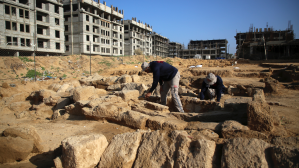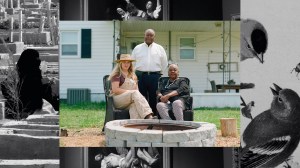In this series

The major biblical archaeology stories of 2023 contain a lot of doom, destruction, and disappointment. They also contain mysteries that may be resolved by future excavations—and perhaps, in one case, the resolution of an ongoing controversy that has dogged New Testament scholars for the past decade.
The truly important discoveries of 2023, of course, may not be known for years, as it takes time for archaeologists to carefully study the results of their research and then publish their findings in scientific journals. But these are some of the stories that generated headlines for biblical archaeology in 2023.
10. Lost graves in Gaza
Near the end of September, archaeologists in Gaza announced the discovery of graves in a Roman-era cemetery. Crews working under French archaeologist René Elter uncovered important information about the lives of inhabitants along this coastal trade route 2,000 years ago. They found two extremely rare lead coffins—one decorated with ornate grape leaves, the other with images of dolphins—suggesting social elites had been buried there.
“An inconspicuous construction lot—surrounded by a grove of nondescript apartment buildings—has become a gold mine for archaeologists,” the Associated Press reported.
Two weeks later, Hamas militants from Gaza attacked Israel, precipitating a costly war that has probably leveled those nondescript apartment buildings, displacing and perhaps killing their inhabitants. The fate of those working on the site and the site itself is currently unknown. Elter responded to a query about his safety but did not elaborate on the excavation.
The war, of course, disrupted the work of the Israel Antiquities Authority (IAA) across Israel. Some IAA archaeologists with expertise acquired studying ancient disasters found their skills needed for a different kind of work. They were called in to Jewish communities attacked by Hamas to help discover and identify the human remains.
“It is one thing to expose 2,000-year-old destruction remains, and quite another thing—heart-rending and unfathomable—to carry out the present task searching for evidence of our sisters and brothers in the settlements,” the IAA said.
They discovered evidence that helped identify at least 10 dead people previously considered missing.
9. Ancient Israelite DNA
Almost lost in news of war was the early October announcement of the recovery of ancient Israelite DNA from the First Temple period. Genetic material was extracted from two individuals whose remains were found in a family tomb west of Jerusalem, dating to around 750–650 B.C.
The achievement was described as “a Holy Grail in the study of lost civilization” that “promises to pave the way for further research on longstanding questions about the origins of the ancient Israelites.”
The preliminary results were to be discussed at a conference on new archaeological discoveries, but the gathering was postponed due to the conflict between Israel and Hamas.
8. Earliest evidence of ancient warfare
The Bible describes wars going back to the time of Abraham in Genesis 14. Now archaeologists have uncovered evidence of armed conflict from several thousand years earlier, in the Early Chalcolithic period, about 5800–4500 B.C.
Hundreds of sling stones—smoothed into a uniform, aerodynamic shape—were uncovered at two different sites in Israel. This indicates organized preparation for battle. The size of the two prehistoric sites in Lower Galilee and the northern Sharon plain show that many people were required for war preparation.
7. The leveling of Antioch
In 2022, Turkish archaeologists began work for the first time in the residential areas of Antakya, the site of the ancient city of Antioch, where followers of Jesus were first called Christians. The excavation raised hopes about the possibility of many new discoveries about life in Antioch. But then an earthquake struck Turkey and Syria on February 6.
Antakya was one of the most devastated cities, with more than 35,000 dead. The old part of the city, including monuments to its diverse history going back to the first century and earlier, was left in rubble. Plans for excavation are permanently on hold.
6. The disappointment of Siloam
For almost two decades, visitors to Jerusalem have been shown the steps that lined one side of the Pool of Siloam in New Testament times. The pool was a place for ritual cleansing for Jewish pilgrims before they ascended to the temple. In John 9, Jesus heals a blind man and tells him to go wash in the Pool of Siloam.
The steps were accidentally uncovered during a 2004 sewer repair. But the excavation was limited to preserve an orchard. Archaeologists and local authorities were tantalized by the possibility of finding more, though, and decided to raze the orchard for a fuller dig. Nothing was found. The steps were apparently preserved when a road was built over them, but the rest of the stones of the pool are not there. They were likely taken in ancient times for other building projects.
5. Psalm 86 found atop a desert mountain
Archaeologists hiked to Hyrcania, a fortress atop a desert mountain overlooking the Dead Sea, for a first season of excavations. The fortress was built by the Hasmoneans, then used as a prison by Herod the Great, and then as a Byzantine monastery. Amid a layer of collapsed building stones, archaeologists discovered, painted in red, a simple graffiti cross with an inscription underneath. It was a prayer quoting, in part, Psalm 86: “Jesus Christ, guard me, for I am poor and needy.”
The inscription has been dated to the sixth century A.D., judging by the epigraphic style.
4. David and Solomon regain stature
Dismissed as minor chieftains by biblical minimalists for several decades, the Israelite kings of 3,000 years ago showed remarkable resilience in 2023. A mid-year article by Hebrew University archaeologist Yosef Garfinkel reviewed excavations at five sites surrounding Jerusalem and concluded that their similar fortifications and other urban features matched the biblical description of a centralized kingdom in that timeframe.
“These cities aren’t located in the middle of nowhere,” he wrote. “It’s a pattern of urbanism with the same urban concept.”
The archaeologists, who had excavated Tel Gezer for a decade, published radiocarbon test results in November that located the construction of Gezer’s famous six-chambered gateway in the first half of the 10th century B.C. This seems to lend support to 1 Kings 9:15, which describes Solomon conscripting labor to work on Jerusalem, Hazor, Megiddo, and Gezer.
“This puts David and Solomon back on the table for being involved in at least some of the monumental architecture in the area,” said Lyndelle Webster of the Austrian Archaeological Institute, the lead author of the study.
3. Mud brick arch mystery at Tel Shimron
An extraordinarily well-preserved mud brick arch has been carefully uncovered at the acropolis of a Canaanite city overlooking the Jezreel Valley in northern Israel. The arch leads from a vaulted corridor deep into the tel, a layered archaeological mound. Its end has not yet been uncovered.
The purpose of the arch is not yet known, though some have speculated it has cultic significance. The arch appears to have been preserved by being re-buried shortly after construction.
Shimron, little mentioned in the Bible, was largely overlooked by archaeologists until the current dig started in 2017. The city covered 48 acres at its height in the Middle Bronze period, 4,000 years ago.
2. Identifying Bethsaida on the Galilee shore
Archaeologists have been carefully digging into the remains of a Byzantine basilica near the Sea of Galilee, convinced that they are uncovering the true site of Bethsaida. Last year, they found a mosaic inscription referencing “the chief and commander of the heavenly apostles,” which suggests this ancient church may have been built to commemorate Peter. According to tradition, the Church of the Apostles was built over the house of the apostles Peter and Andrew. That find was number 6 on our list of 2022 archaeology stories.
This year the excavation receives top billing for the discovery, deep under the apse, of the remains of a first-century wall. The find adds more weight to the argument that this is the historic Bethsaida and not et-Tel, a site several miles inland.
Continued excavation could tell us more about the lives of the early apostles. John calls Bethsaida the city of Andrew and Peter. Mark, however, suggests he lived in Capernaum. Did Peter live in two different fishing villages? An excavation in the mid-20th century claimed to have unearthed Peter’s home. The site is now occupied by an ultra-modern, flying-saucer–shaped church. Perhaps clarity will come with more archaeology.
1. Jerusalem’s mysterious moat
Archaeologists were mystified by channels dug into the bedrock in the oldest part of Jerusalem. Could they have been designed for some kind of industrial liquid production? Experts ventured various guesses and even called in a CSI team from the Jerusalem Police Department to try to solve the mystery.
Then they figured out it was part of a moat dating to the ninth century. According to a report, published this fall, the moat separated the Temple Mount from the older, lower City of David area when Jerusalem was the capital of Judah, and possibly hundreds of years earlier.
"In all our reconstructions of what Jerusalem looked like back then, we just have a continuous urban landscape from the Temple Mount down to bottom of the City of David,” excavation co-director Yiftah Shalev said. “This discovery completely changes that picture."
The moat, almost 100 feet wide and at least 20 feet deep, had been seen in Kathleen Kenyon’s earlier excavations further to the east, but experts thought it was a natural feature of the landscape, not part of the architecture of the city. But Shalev and his team have concluded that the moat created a barrier between the temple, the palace, and the area where the rest of the people lived. In an earlier era, before the temple and palace were built, it may have protected the city from a northern attack.
This particular excavation, known as the Givati Parking Lot excavation, has produced many amazing discoveries since it began in 2007, including a hoard of gold coins from the Byzantine era and ceramic roof tiles dating to the Hellenistic period. Dig co-director Yiftah Shalev estimates another year of work is still to be done.
Bonus: One of the most exciting finds announced in Israel this year was not technically from the biblical period. Archaeologists entered a cave near the Dead Sea to get a better look at a previously spotted stalactite inscription. In the upper part of the cave, they spotted a shafted pilum, a spear-like weapon. On further inspection, they found a cache of well-preserved Roman swords, apparently taken from soldiers during the Bar Kokhba revolt, A.D. 130–135. The swords were still in their wooden and leather scabbards.
Gordon Govier writes about biblical archaeology for Christianity Today, hosts the radio program The Book & The Spade, and is the editor of the biblical archaeology newsmagazine ARTIFAX.





























